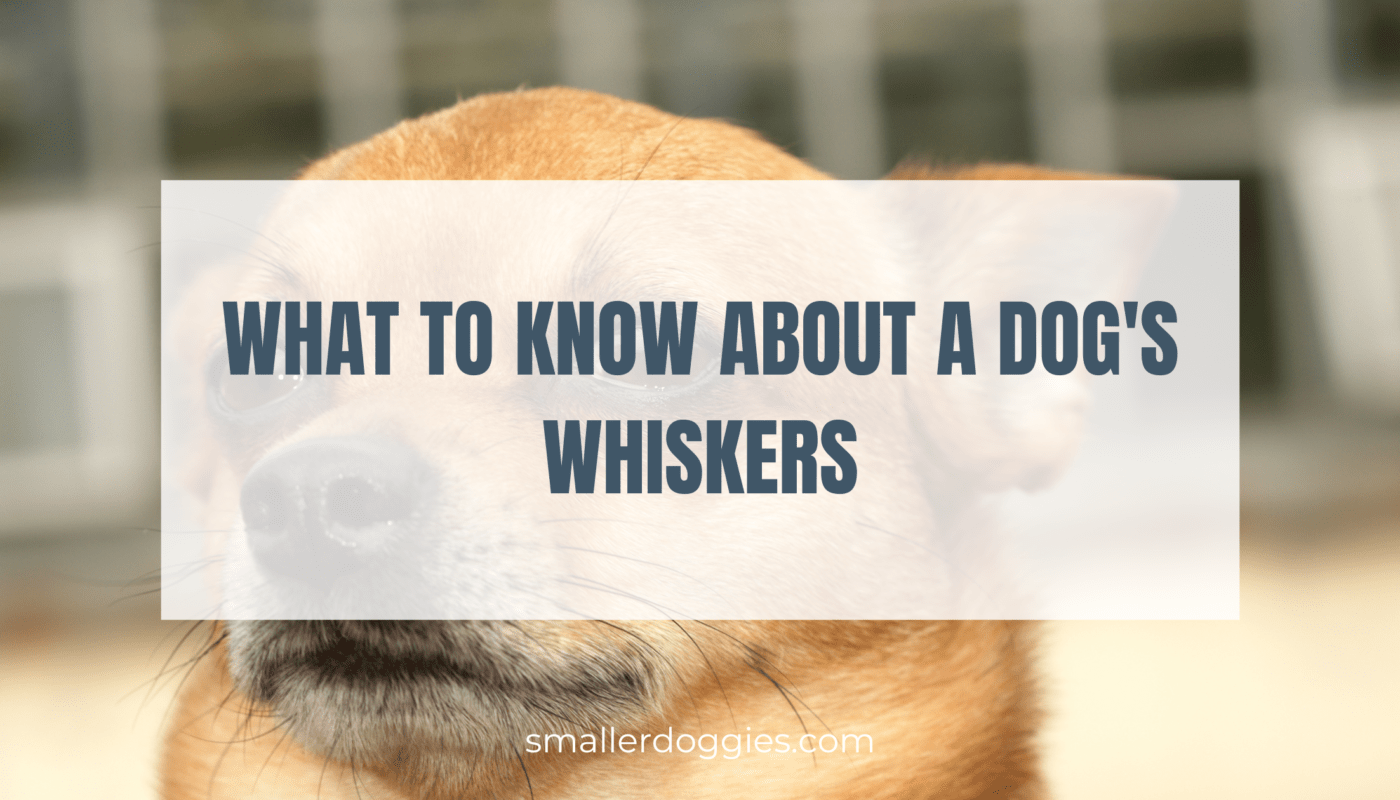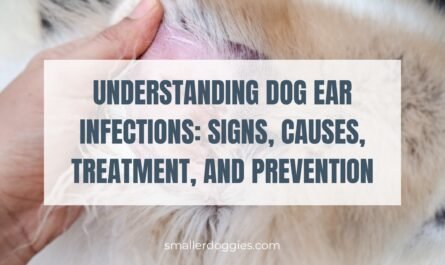Post Disclaimer
This post may contain affiliate links. If you use these links to buy something we earn a commission at no extra cost to you. Smaller Doggies is supported by its audience, Thank you!
When you picture whiskers, cats likely come to mind first. Those long, delicate strands are a defining feature of felines. So what about a dog’s whiskers? known by their scientific term vibrissae, which means “to vibrate” in Latin. These sensory tools are nearly universal among mammals, including humans, who retain vestigial muscles for them in our upper lip.
In dogs, the length and number of these vibrissae can differ based on the breed. Though whiskers are commonly studied in species like rats and mice, our understanding of dog whiskers remains limited. With further research, our knowledge could expand significantly, potentially revealing new insights into the unique characteristics and purposes of these fascinating features across different breeds.

Table of Contents
- Dog Whisker Anatomy
- What Are Dog Whiskers Made Of?
- Are Dog Whiskers Sensitive?
- What Are Dog Whiskers For?
- Can You Cut Dog Whiskers?
- Do Dog Whiskers Shed?
Dog Whisker Anatomy
Dogs possess two types of whiskers: long and short. The long whiskers, known as macrovibrissae, are not typically moved voluntarily by dogs, in contrast to some mammals. The short whiskers, called microvibrissae, help transmit tactile information to the brain, much like human fingertips.
Types of Dog Whiskers:
- Genal Whiskers: These cheek whiskers enhance your dog’s peripheral vision.
- Interramal Tufts: Located below the chin, they help sense objects beneath the face.
- Mystacial Whiskers: Positioned on the upper lip, these are the most prominent whiskers on your dog’s muzzle.
- Supraorbital Whiskers: Found above the eyes, resembling eyebrows.
Whiskers in dogs are more robust and substantial compared to regular hairs. Whisker follicles are notably larger and rich in nerve endings. The surface of a whisker is smooth, tapering to a more flexible tip.
Upon contact with a surface, whiskers bend, triggering receptors within the follicle. These receptors then relay information about the contact object to your dog’s brain.
Whisker development in dogs might begin before other hairs, potentially indicating their importance for sensory information in newborns. Studies in rodents show critical brain development and behavior linked to early whisker sensation. This phenomenon might also be applicable to canine development.
What Are Dog Whiskers Made Of?
Dog whiskers are composed of keratin, the same protein found in hair, skin, and nails. These whiskers, unlike regular hair, are curved, tapered strands. Whiskers grow from unique follicles that are deeper under the skin’s surface than those of regular hair. Additionally, whiskers are longer, more rigid, and have a higher concentration of nerves attached to them, making them more sensitive than other types of fur.
Are Dog Whiskers Sensitive?
Dog whiskers are indeed highly sensitive. They serve as a sensory organ akin to human fingertips, packed with numerous nerves. This makes them capable of feeling even light touches and changes in air currents.
Whiskers provide dogs with vital sensory information, aiding their sense of touch. They help dogs navigate and sense the environment, preventing collisions and reducing stress. Despite not being as sensitive as those of rats or mice, whiskers still play a crucial role in a dog’s sensory system.
What Are Dog Whiskers For?
Dog whiskers have a variety of crucial functions that aid them in navigating their environment. These specialized hairs, known as vibrissae, serve as touch sensors, giving dogs spatial awareness even in dim light or darkness. The whiskers can detect subtle changes in air currents, which helps them avoid obstacles like walls and navigate spaces effectively.
Key Functions of Dog Whiskers:
- Navigation: Whiskers act like radar detectors, helping dogs sense objects and move around safely.
- Emotional Communication: Whiskers can communicate emotions, flaring when dogs feel threatened.
- Hunting and Protection: In hunting and when swimming, they protect sensitive areas by detecting potential threats.
Whiskers play a significant role in your dog’s ability to interact with its surroundings and adapt its behavior accordingly.
Can You Cut Dog Whiskers?
Not recommended. Dog whiskers should never be cut unless medically necessary. Cutting or trimming a dog’s whiskers can cause significant distress and lead to confusion and disorientation. Whiskers play a crucial role in a dog’s spatial awareness, helping them navigate and avoid getting stuck in tight spaces.
Trimming whiskers is different from typical grooming practices. It is more akin to a temporary amputation than a simple haircut. In rare instances, a veterinarian might trim whiskers to treat a facial wound, but this should never be done by a dog owner or groomer.
Whiskers can break, especially if your dog enjoys rough play. It’s important to be gentle around these sensitive areas and ensure children do not pull on them. While whiskers themselves don’t contain nerves, the follicles do, making the act of pulling out a whisker highly painful and potentially causing bleeding.
In the event that whiskers are broken or cut, it may take up to two months for them to grow back fully. Handling your dog’s whiskers with care is essential for their comfort and well-being.
Do Dog Whiskers Shed?
Dog whiskers do shed occasionally, which is entirely normal. Excessive shedding, though, can indicate health issues. Various problems can lead to whisker loss. For example, alopecia areata is an autoimmune disease that causes dogs to lose whiskers, body hair, and even eyelashes.
Dental problems might also result in whisker loss. If you notice your dog shedding a lot of whiskers or if they have brittle whiskers that break easily, consult your veterinarian. Skin infections, mange, and other health conditions might be the culprits. Ensuring timely veterinary care can help identify and treat these issues effectively.
Understanding a dog’s whiskers reveals a fascinating aspect of their sensory world. These specialized hairs, or vibrissae, serve numerous critical functions, from aiding navigation to communicating emotions and detecting environmental changes. Their robust structure and sensitive nature underscore their importance in a dog’s daily life.
While whiskers are naturally shed and can break during rough play, they should never be cut or trimmed without medical necessity, as this can cause significant discomfort and disorientation. By appreciating and protecting these essential features, we can ensure our canine companions navigate their world with confidence and ease.







